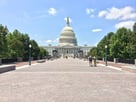 Nearly all regulatory laws provide for civil – and sometimes even criminal – penalties for noncompliance. Penalty amounts (“XXX dollars per day of violation” for example) are typically adopted as part of the original legislation. But over time, the relative sting of these penalties declines with inflation. To counteract the possibility that less painful penalties will be less effective incentives for compliance, U.S. federal law has directed most agencies to make periodic “cost of living” adjustments to maximum available civil penalty levels (there are no provisions for standing periodic adjustments to criminal penalties).
Nearly all regulatory laws provide for civil – and sometimes even criminal – penalties for noncompliance. Penalty amounts (“XXX dollars per day of violation” for example) are typically adopted as part of the original legislation. But over time, the relative sting of these penalties declines with inflation. To counteract the possibility that less painful penalties will be less effective incentives for compliance, U.S. federal law has directed most agencies to make periodic “cost of living” adjustments to maximum available civil penalty levels (there are no provisions for standing periodic adjustments to criminal penalties).
How Did These Requirements Work During 1990-2016?
The first version of this approach was enacted by the Federal Civil Penalties Inflation Adjustment Act of 1990, which directed the President to report annually on any adjustments made under existing statutory authority, and to calculate what such adjustments would have been if more agencies had the authority to make them.
Congress amended the Act in 1996 to require most agencies to make inflation adjustments every four years, but precluding adjustments to penalties under the following:
-
Internal Revenue Code
-
Occupational Safety and Health Act
-
Social Security Act
-
Tariff Act
What Changes Become Effective in 2016?
The federal budget for Fiscal Year 2015 revised these provisions to:-
Require annual adjustments, beginning July 1, 2016 and no later than each January 15 thereafter, based on Consumer Price Index levels as of the preceding October, compared with the level when the penalty provision was enacted (the 1970s for many environmental health and safety provisions, the 1930s for securities laws, etc).
-
Remove the previous “rounding” requirement (multiple of $10 for penalties less than or equal to $100, etc) and direct adjustments to the nearest whole dollar.
-
Remove the exclusion for the Occupational Safety and Health Act and the Social Security Act.
-
Capped the 2016 adjustment to no more than 150% of the rate in effect when the 2015 amendments were enacted
Most agencies made their 2016 adjustments – in August the Government Accountability Office (GAO) reported that 49 of 52 agencies had done so, although some were late. (I wrote about the 2015 amendments here, and delayed this update blog in the vain hope I could say they all have done so). Most are also moving during 2017 to make their first annual adjustment. The two most important federal environmental health and safety *(EH&S) agencies have done so:
-
Environmental Protection Agency (EPA) adjustments to Clean Air Act penalties (most were $25,000 per day when adopted in 1977) are now $45,268 per day of violation. Clean Water Act penalties (most were $25,000 per day when adopted in 1972) are now $52,414.
-
Occupational Safety and Health Administration (OSHA) penalties (most were $7,000 per day when adopted in 1970) are now $12,675 per day of violation.
Self Assessment Checklist
Is the organization subject to federal regulatory requirements and prohibitions?If so, has the organization established programs to ensure compliance?
If so, do these programs consider the potential impact of civil penalties for violations?
Where Can I Go For More Information?
-
Public Law 114-74 (Bipartisan Budget Act of 2015 (Nov. 2, 2015)), section 701
-
GAO report on 2016 adjustments (Civil Penalties - Certain Federal Agencies Need to Improve Efforts to Comply with Inflation Adjustment Requirements) (GAO-17-634) (August 2017)
Specialty Technical Publishers (STP) provides a variety of single-law and multi-law services, intended to facilitate clients’ understanding of and compliance with requirements. These include:
About the Author
 Jon Elliott is President of Touchstone Environmental and has been a major contributor to STP’s product range for over 25 years. He was involved in developing 13 existing products, including Environmental Compliance: A Simplified National Guide and The Complete Guide to Environmental Law.
Jon Elliott is President of Touchstone Environmental and has been a major contributor to STP’s product range for over 25 years. He was involved in developing 13 existing products, including Environmental Compliance: A Simplified National Guide and The Complete Guide to Environmental Law.
Mr. Elliott has a diverse educational background. In addition to his Juris Doctor (University of California, Boalt Hall School of Law, 1981), he holds a Master of Public Policy (Goldman School of Public Policy [GSPP], UC Berkeley, 1980), and a Bachelor of Science in Mechanical Engineering (Princeton University, 1977).
Mr. Elliott is active in professional and community organizations. In addition, he is a past chairman of the Board of Directors of the GSPP Alumni Association, and past member of the Executive Committee of the State Bar of California's Environmental Law Section (including past chair of its Legislative Committee).
You may contact Mr. Elliott directly at: tei@ix.netcom.com

